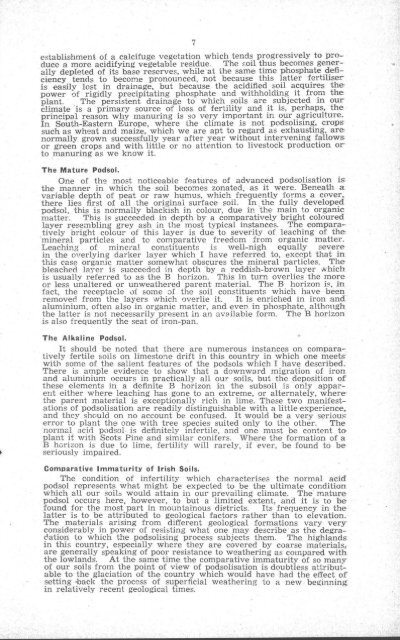Download Full PDF - 21.17 MB - The Society of Irish Foresters
Download Full PDF - 21.17 MB - The Society of Irish Foresters
Download Full PDF - 21.17 MB - The Society of Irish Foresters
You also want an ePaper? Increase the reach of your titles
YUMPU automatically turns print PDFs into web optimized ePapers that Google loves.
7establishment <strong>of</strong> a calcifuge vegetation which tends progressively to producea more acidifying vegetable residue. <strong>The</strong> wil thus becomes generallydepleted <strong>of</strong> its base reserves, while at t.he same tiJ:le phosphate .d,eficiencytends to become pronounced, not beca~s~. thIS latter f.erhhseris easily lost in drainage, but because the aCIdIfied sOlI acqUires thepower <strong>of</strong> rigidly precipitating phosphate and withholdin~ it fro:n theplant. <strong>The</strong> persistent drainage to which soils are subjected m ourclimate is a primary source <strong>of</strong> loss <strong>of</strong> fertility and it is, perh~ps, theprincipal reason why manuring is so very important m our agnculture.In South-Eastern Europe, where the climate is not podsolisin~, cropssuch as wheat and maize, which we are apt to regard as exhaustmg. arenormally grown successfully year after year without intervening f~llowsor green crops and with little or no attention to livestock productIOn orto .manuring as we know it.<strong>The</strong> Mature Podsol.One <strong>of</strong> the most noticeable f~atures <strong>of</strong> advanced podsolisation is:the manner in which the soil becomes zonated. as it were. Beneath avariable depth <strong>of</strong> peat or raw humus, which frequently forms a cover,there lies first <strong>of</strong> all the originai surface soil. In the fully developedpodsol. this is normally blackish in colour, due if>. ihe main to organicmatter. This is succeeded in depth by a comparatively bright colouredlayer rese;nbling grey ash in the most typical instances. <strong>The</strong> comparativelybright colour <strong>of</strong> this layer is due to severity <strong>of</strong> leaching <strong>of</strong> themineral particles af>.d to comparative freedom from organic matter.Leaching <strong>of</strong> mineral constituents is well-nigh equally severein the. overlying darker layer which I hav.e referred to, except that inthis case organic matter somewhat obscures the mineral particles. <strong>The</strong>bleached layer is succeeded in depth 'by a reddish-brown layer whichis usually referred to as the B horizon. This in turn overlies the moreor less u'naltered or unweathered parent material. <strong>The</strong> B horizon i~, infact, the receptacle 0i some <strong>of</strong> the soil constituents which have beenremoveCl. from the layers which overlie it. It is enriched in iron andaluminium, <strong>of</strong>ten also in organic matter, and even in phosphate. altho\lghthe latter is not necessarily present in an available form. <strong>The</strong> B horizonis also frequently the seat <strong>of</strong> iron-pan.<strong>The</strong> Alkaline Podsol.It should be noted that .there are numerous instances on comparativelyfertile soils on limesto:1e drift in this country in which one meetswith some <strong>of</strong> the salient features <strong>of</strong> the podsols which I have described.<strong>The</strong>re is ample evidence to show that a downward migration <strong>of</strong> ironand aluminium occurs in practically all our soils, but the deposition <strong>of</strong>these elements in a definite B horizon in the subsoil is only apparenteither where leaching has gone to an extreme, or alternately, where'the parent material is exceptionally rich in lime. <strong>The</strong>se two manifestations<strong>of</strong> podsolisation are readily distinguishable with a little experience,and they should on no account be confused. It wouln be a very seriouserrorto plant the one with tree species suited only to the other. <strong>The</strong>norm",l acid podsol. is definitely infertile. and one must be content toplant it with Scots Pine and similar conifers. Where the formation <strong>of</strong> aB hvrizon is due to lime, fertility will rarely, if ever, be found to be'seriously impaired.Comparative Immaturity <strong>of</strong> <strong>Irish</strong> Soils.<strong>The</strong> condition <strong>of</strong> infertility which characterises the normal acidpod sol represents what might be expected to be the ultimate conditionwhich all our soilii would attain in our prevailing climate. <strong>The</strong>' maturepodsol occurs here, however, to but a limited extent, and it is to be'found for the most part in mountainous di~tricts. Its frequency in thelatter is to be attributed to geological factors rather than to elevation.<strong>The</strong> materials arising from different geological formations vary veryconsiderably in power <strong>of</strong> resi5ting what one may describe as the degracationto which the podsolising process subjects them. <strong>The</strong> highlandsin this country, especially where they are covered by coarse materials,are generally speaking <strong>of</strong> poor resistance to weathering as compared withthe lowlands. At the same time the comparative immaturity <strong>of</strong> so many<strong>of</strong> our soils from the point <strong>of</strong> view <strong>of</strong> podsolisation is doubtless attributableto the glaciation <strong>of</strong> the country which would have had the effect <strong>of</strong>setting -back the process <strong>of</strong> superficial weathering to a new beginningin relatively recent geological times.
















